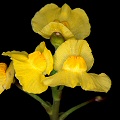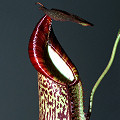Q: Do carnivorous plants have ethnobotanical uses?

U. foliosa

Nepenthes hybrid
A:Ahh, but of course they do! But this should be no surprise, since there are
several hundred species of carnivorous plants. Below I have listed but a
few of these purported uses. (Incidentally, on this page, I use the phrase "ethnobotanical
use" to indicate a nonmedicinal application. For medicinal uses,
check the previous page.)
Here are a few ethnobotanical uses for carnivorous plants:
- Curdling milk (Pinguicula, Drosera, Nordic countries)
- Making rope (Nepenthes ampullaria, Indonesia)
- Container for steaming rice (Nepenthes sp., Philippines)
- Ornamental use (Sarracenia leucophylla, San Francisco USA)
- A food sweetener (Byblis, Australia)
- Flycatchers (Drosophyllum, Portugal)---this may be anecdotal
- Kinky sex toy (Utricularia, USA, my place, only once)---I don't want to talk about it.
Oddly enough, the most common uses you hear about involving carnivorous plants involve Pinguicula vulgaris being used in Nordic countries. For examples, I have heard of it being used as a way to curdle milk, as a balm for the udders of milk-producing ungulates, and even (somehow) as a method of enhancing a sheen on the hair of Nordic blondes. This last factoid was provided by a FAQ-reader from Denmark, who told me that there is some connection with Pinguicula vulgaris and meade, and that some concoction of the two--called Vibefedt--was used to enhance some sort of visions, much like you might get from mixing Tequila and Rum. My Denmark informant says there is an ancient pair of runic inscriptions that reads:
and
By the way, Vibefedt means "lapwing grease", and apparently
derives from the fact that greasy little Pinguicula vulgaris lives
in cold places that also support lapwings--a small plover with crazy head feathers. Damn, I couldn't make up
stuff this weird, unless maybe I was slamming down the Vibefedt myself!
A really fine ethnobotanical use involves Nepenthes mirabilis in New Guinea. There, the pitcher is
used by men as an attractive sheath for their penises. Oh yes, very nice. If you don't believe me--and why would I lie about
this?--google "koteka". Usually the koteka is made out of a hollowed troot, but sometimes
Nepenthes are used instead.
Then, think of me the next time you see Nepenthes mirabilis pitchers.
Especially if the pitchers are large. Really large.
Page citations: Alm, T. 2005; Clarke, C. 1997, 2001; Gibson, R. 2000 (personal communication);
Lee, C. 2000 (personal communication); Juniper, B.E. et al. 1989; Rice, B.A. 2006a; personal
observation, reader contributions.